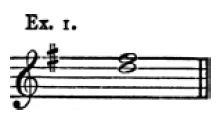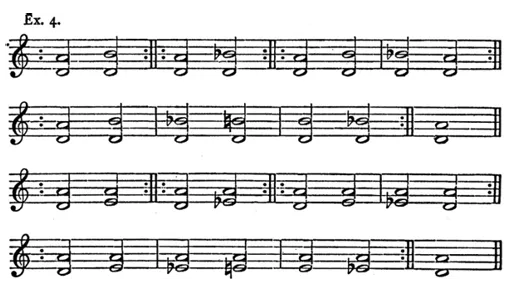![]()
IX
DOUBLE-STOPPING
IN discussing the subject of double-stopping it is necessary to deal further with the delicate question of purity of intonation. At the risk of repeating myself to some extent I shall emphasize here certain points that are of vital importance in the art of violin playing.
In double-stopping, as in playing generally, purity of intonation can come only through a habit of concentrated listening. Fingers cannot learn to play in tune, but they will readily become obedient servants to the ear and follow its commands, or, to put it more exactly, they will become readily responsive to the demands of the musical intelligence which controls them. Playing with pure intonation is the direct result of true mental hearing—that is, having a clear mental conception of the note before playing it. The clearer and more definite this mental conception is, the more certain will intonation be. Therefore, practice for intonation must be first of all an exercising of the hearing faculty. The simplest exercises will serve, and indeed are best, for this practice in concentrated listening. Passages that are technically difficult must be analysed and reduced to simple details, and then practised in these small fragments before they can be built up again to be played with pure and certain intonation.
When practising for intonation, and especially in double-stopping, a student needs to be warned against discouragement when things seem to be getting worse instead of better. Actually this is a healthy sign! It means that he is listening with concentration and critically, and that the work is therefore being well done. But he will need some careful direction at this point, or he may be confused by what he does not understand. In the tempered scale of a keyed instrument, any particular note is, of course, always precisely the same pitch, whatever the key. In just intonation a note will vary in pitch with changes of key. The note F#, for instance, is not absolutely the same pitch in the key of D as in the key of A. And even in the same key a note will vary to some extent through psychological influence. For instance, F# in the key of G has a certain frequency. If we play a major third containing that note (Ex. 1) the F# has its true frequency. If we play the note in a
succession of single notes (Ex. 2) the ear demands that, as leading
note, it shall be slightly sharper than its true frequency. That is what I mean by psychological influence, and we are faced with the above curious anomaly, which may puzzle and distress the student who is not forewarned. In his enthusiasm and thoroughness he might set himself to devise exercises in double-stopping, and he might hit upon some such simple and logical example as shown in Ex. 3. Ascending to the tonic, he would instinctively make the
leading note very sharp. Then, dropping to the D and playing the third, he would find the two notes not in tune together. He would perhaps blame himself and his imagined imperfection of hearing, instead of realizing that every keen-eared musician would have the same difficulty to contend with, and that the difficulty had arisen, not on account of dullness in himself, but because his hearing had been true!
This brings up what will now be an obvious fact, that there is no absolutely exact spot on the finger-board for any one note. A beginner must work as though there were such an exact spot, and must diligently practise to find it, for it is, of course, necessary to learn approximate intonation—merely to play ‘in tune’—before the finer art of pure intonation can gradually be acquired.
Realizing the variableness of pitch in just intonation, a student might easily feel despondent of ever being able to achieve purity in this respect. Let him put his mind at ease! A musically sensitive ear is an almost infallible guide, and that which seems to be a physical impossibility becomes comparatively quite easy when controlled entirely by the musical intelligence and imagination. All we have to do, therefore, is to train the ear. By the ear I mean not only the critical hearing faculty, but also the musical imagination, through which a clear conception of a note is formed before the note is played. Then we must trust this sensitive intelligence, and it will lead us towards perfection. Under conditions that make just intonation practicable—as in a string quartet, for instance—we may have beauty and expressive power of tone that can never be achieved with the tempered scale. Under such conditions finely trained artists will play naturally and easily in just intonation—more easily in fact than they will adapt their playing to the tempered scale when playing with piano accompaniment.
Double-stopping may be quite easy to play, or it may be extremely difficult by reason of big stretches and strained positions of hand and fingers. This kind of difficulty can be overcome only by much intelligent hard practice and development of the hand and fingers. But except where this physical effort is necessary, double-stopping should not present great difficulty.
Like all other technical matters it must develop from the simplest and easiest beginnings. The easiest possible combination of two notes is two adjacent open strings. This is not, strictly speaking, a stop at all, but it is our starting point. The next step will be an open string and one stopped note, and we might devise for the beginner an exercise such as Ex. 4. This should be practised also on the A and E strings and on the G and D:
After exercising the first finger with an open string, the second finger may be used in some such way as this:
leadi...





